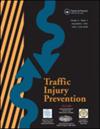Effects of dual-message tactile sliding takeover requests on takeover performance in an automated driving system
IF 1.6
3区 工程技术
Q3 PUBLIC, ENVIRONMENTAL & OCCUPATIONAL HEALTH
引用次数: 0
Abstract
Objective
The present study aimed to explore the effects of various tactile takeover requests (TORs) (i.e., tactile sliding TOR and traditional vibration TOR) on the takeover performance in an automated driving system.
Methods
A tactile sliding motor device was developed to signal the sliding TOR on the seatback of a driving simulator. Twenty-five young drivers were recruited as participants. Four types of TOR patterns were adopted in the study: ipsilateral motor rotation (IR), contralateral motor rotation (CR), ipsilateral and contralateral motor rotation (ICR), and ipsilateral motor vibration (IV). The participants were required to sit on the seat and underwent the automated driving in a low- or high-complexity scenario, then one of the four types of TORs was triggered randomly. The participants were asked to make a lane change using the steering wheel as soon as possible. Objective measures and subjective evaluations were used to assess the takeover performance.
Results
Results showed that the participants exhibited a shorter steering response time and lane change time under the three tactile sliding TORs (compared to the traditional vibration TOR). In the high-complexity scenarios and low-complexity scenarios conditions, different result patterns appeared regarding the maximum lateral acceleration and situational awareness.
Conclusion
Our findings suggested that the tactile sliding motor is a promising way to signal a TOR in an automated driving system.
自动驾驶系统中双信息触觉滑动接管请求对接管性能的影响。
研究目的本研究旨在探讨各种触觉接管请求(TOR)(即触觉滑动接管请求和传统振动接管请求)对自动驾驶系统中接管性能的影响:方法:开发了一种触觉滑动马达装置,用于在驾驶模拟器的座椅靠背上发出滑动 TOR 信号。招募了 25 名年轻驾驶员作为参与者。研究采用了四种 TOR 模式:同侧运动旋转(IR)、对侧运动旋转(CR)、同侧和对侧运动旋转(ICR)以及同侧运动振动(IV)。受试者被要求坐在座椅上,在低复杂度或高复杂度场景中进行自动驾驶,然后随机触发四种 TOR 中的一种。参与者被要求尽快使用方向盘变道。采用客观测量和主观评价来评估接管表现:结果表明,与传统的振动 TOR 相比,参与者在三种触觉滑动 TOR 下的转向反应时间和变道时间更短。在高复杂度场景和低复杂度场景条件下,最大横向加速度和态势感知方面出现了不同的结果模式:我们的研究结果表明,触觉滑动电机是自动驾驶系统中发出 TOR 信号的一种有前途的方式。
本文章由计算机程序翻译,如有差异,请以英文原文为准。
求助全文
约1分钟内获得全文
求助全文
来源期刊

Traffic Injury Prevention
PUBLIC, ENVIRONMENTAL & OCCUPATIONAL HEALTH-
CiteScore
3.60
自引率
10.00%
发文量
137
审稿时长
3 months
期刊介绍:
The purpose of Traffic Injury Prevention is to bridge the disciplines of medicine, engineering, public health and traffic safety in order to foster the science of traffic injury prevention. The archival journal focuses on research, interventions and evaluations within the areas of traffic safety, crash causation, injury prevention and treatment.
General topics within the journal''s scope are driver behavior, road infrastructure, emerging crash avoidance technologies, crash and injury epidemiology, alcohol and drugs, impact injury biomechanics, vehicle crashworthiness, occupant restraints, pedestrian safety, evaluation of interventions, economic consequences and emergency and clinical care with specific application to traffic injury prevention. The journal includes full length papers, review articles, case studies, brief technical notes and commentaries.
 求助内容:
求助内容: 应助结果提醒方式:
应助结果提醒方式:


